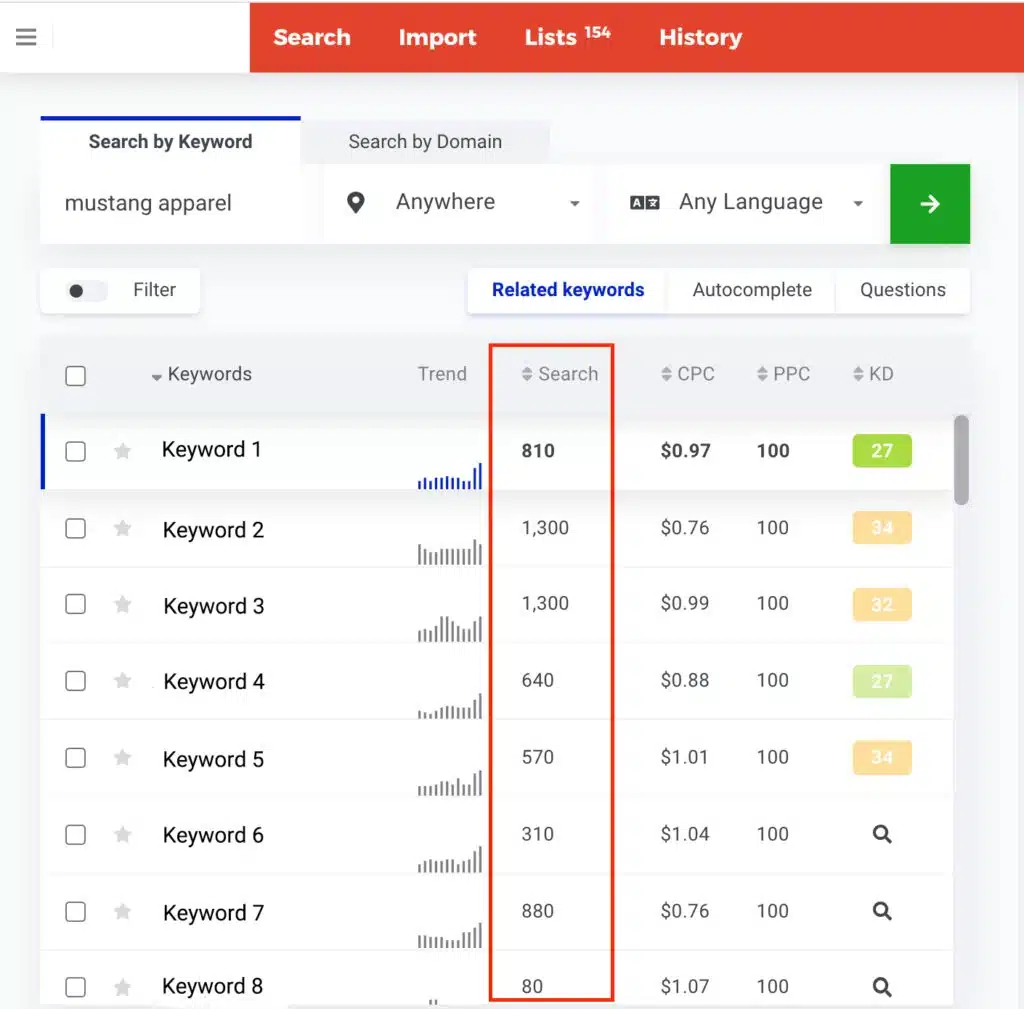All effective content strategies share one thing in common: keyword research. Without target keywords, your content strategy is less of a plan and more a wish. Keywords serve as the foundation for any optimization efforts. Keyword mapping creates pillars for your site’s structure and the supplemental content that will draw in visitors.
While it’s possible to have multiple rankings for one specific keyword, your efforts are better spent optimizing your website’s various pages for unique keyword groups. This is where keyword mapping comes in.
Below we’ll dive deep into the keyword mapping process, why it’s essential, and how to use a keyword map to drive a strong content strategy for your website.
What is Keyword Mapping?
Keyword mapping is the art of finding valuable search queries and matching them to relevant pages on your site. After a deep dive into primary keywords, long-tail keywords, and related keywords you want your website to rank for, common search queries are placed side-by-side with current site pages. Then, specific sets of keywords are assigned to the pages you want them to rank for in a keyword map.
Keyword mapping is considered one of the most important aspects of on-page search engine optimization. SEO allows you to make specific recommendations to help make the page more relevant to the mapped keywords. By doing this, you also enable search engines like Google or Bing to determine a page’s relevancy based on a user’s search. Pages that are deemed highly relevant are then ranked higher in search engine results pages (SERPs).
Without initial keyword research and a detailed keyword map, your guess is as good as anyone’s when creating content users will read and search engines will favor. And your “strategy” will be just that: a guess. However, the downsides of not developing a keyword map—or at the very minimum, a keyword strategy—don’t stop there.
Why is Keyword Mapping Important?
Keyword mapping is essential for several reasons. For one, failing to establish a keyword strategy can lead to keyword cannibalization, when multiple pages on your website compete for the same search query and eat away at each other’s probability to rank. Not only will keyword cannibalization reduce the impact SEO has on your site, but it can destroy organic search acquisition as well. Sometimes, Google will give a higher ranking to a page you didn’t even mean to prioritize, but that shared the same keyword as another well-optimized page.
If optimization is your need, keyword strategy is the solution. Keywords and pages aren’t created equal, and a developed keyword map can help you determine the priorities of your optimization efforts and isolate keyword groupings for specific high-traffic pages. From here, you can also effectively organize your internal link building to create clear associations between related pages.
Secondly, keyword mapping is paramount for a cohesive and effective content strategy. Without target keywords, you risk crafting pages that reflect what you would search rather than people’s general population. When you perform keyword research, you realize that people tend to think (and search) differently than you do. Your content must reflect real searches, not what you think others are seeking.
When it comes time to plan your content strategy, keyword mapping also positions upcoming material with the highest chances to succeed. Instead of shooting in the dark, keyword mapping illuminates the necessary terms to include within the content. It can even inform content basics such as overall word count, page title, <H1> tags, and more. A well-defined keyword strategy will make content ideation easier, as it provides a glimpse into real-time search queries that can form the basis of new pages, articles, or blog posts.

How to Find the Right Keywords to Use
Well-researched keywords are at the heart of every robust keyword map. Before you can even plan your keyword map, you need to decide on a list of keywords you want to or already do rank for in searches. Even with a list of possible keywords in mind, you should still know which searches bring users to your site.
There are a few things to consider when finding the right keywords to use:
- Search intent
- Search volume
- Keyword difficulty
- Keyword research tools
1. Understand Search Intent
Search intent is what a user is thinking when they enter a specific search query and how they plan to use that information. For instance, consider running a business that provides podcast production services specifically to companies creating health and wellness podcasts. In your head, you might think a good keyword for your business is “health and wellness podcast.” However, do you think the user searching for a “health and wellness podcast” is a podcaster seeking podcast production services or an average person on the hunt for a new podcast?
Chances are, the search intent here was for a new podcast find, not the services your business offers. When selecting keywords for your map, try to avoid focusing your strategy on general search queries like in the example above. The content you produce for a specific keyword must match the search intent. If it doesn’t, you have a high chance of users bouncing from the page when they realize it doesn’t meet their purpose.
2. Research Search Volume
Search volume is a data set that displays how many people are looking for a particular query. Search volume should play a massive role when deciding on the right keywords for your keyword map, as this data indicates the popularity of the search. However, bear in mind that search volume numbers are estimates, not hard and fast analytics.
Google’s Keyword Planner provides monthly search volume for various queries and rounds search volume numbers to the closest of 85 buckets. So even if a keyword returns a traffic volume of 165,000, that doesn’t mean it was actually searched that many times—or that it was even close to 165,000 times. In reality, that number was closer than the next volume bucket, which was 201,000. So take search volume results with a grain of salt.
3. Determine Keyword Difficulty
Keyword difficulty measures how hard it is to organically rank in Google’s search results for a specific keyword. Using keyword tools, SEO teams review top-ranking websites for that subject matter and determine KD. Each keyword is given a keyword difficulty score (KDS) which is calculated using several factors derived from the top ranking sites for that keyword, including content quality, page authority, and domain authority. The higher the KDS, the more difficult it will be to rank in organic search results for that term.
A KDS of 30% or lower is considered low difficulty, 30 to 70% moderate difficulty, and 70% or high difficulty. However, similar to search volume, keyword difficulty can range significantly. Each keyword research tool measures keyword difficulty differently, meaning the KDS for the same search term can vary dramatically between platforms. While you should aim for keywords that fall within the 20 to 60% range, also take keyword difficulty scores with a grain of salt.
4. Utilize Keyword Research Tools
If search volume and difficulty scores sound like a lot of work, it is. But SEO teams use keyword research tools to accelerate the process and calculate all of the analytics described above. This way, you get straight to the right keywords and start your keyword map sooner rather than later.
With these tools in mind, it’s important to remember not to get caught up in analytics, such as search volume and difficulty. Your first priority should be if the search intent is there and if the term is genuinely relevant to your business. Now that you know how to research keywords, you can organize them in a keyword map.

How We Create a Keyword Map
Once our team has aligned with our clients on a set of keywords that best represent your content and your business, we create a keyword map. These are presented in a spreadsheet-based mapping document. Each row represents a specific page on your website in your spreadsheet and outlines the most important keywords for that page.
1. Select a Keyword Set
The first step to constructing a keyword map is to have your keyword set in place. Conduct keyword research for each page on your site and, using your keyword research tools, discover the top-ranking keywords for your competitors. Combined, these results should give you a better idea of what your target audience is searching for. Export your results to a clean document.
Once your set of keywords is complete, consider the search intent behind them. Your goal here should be to group keywords that answer the same question or are semantic variations of one another, such as “top bicycles” and “best bicycles.” You can then add long-tail or secondary keywords, such as “best bicycles in Boston,” followed by tertiary keywords. When you’re finished, you should have a variety of groups that pair similar keywords.
2. Input Each Page on Your Site
Next, input each page on your site into a fresh spreadsheet. Remember, pages can be anything on your site, from your homepage to blog posts and landing pages. Each page should receive its own dedicated row. In the first column of the row, input the page ID like “Homepage” or “Bicycle Blog.” In the next column, input the page URL.
3. Designate Keywords for Each Page
Now that you have your keywords set and your pages inputted, it’s time to layout primary, secondary, and tertiary keywords for each page. Remember that the point of keyword mapping is to assign keywords to the pages that you want to rank for them. So, you’ll need to ask yourself, “Which page is most relevant to this particular keyword?”
Variations of keywords, such as synonyms or plural variations, typically get mapped to the same page. Since you’ve already grouped similar keywords, you’ve saved yourself some time mapping all of those keywords to respective pages. Just be sure to include the search volume and keyword difficulty score (KDS) alongside each keyword you put into your map.
Implementing Keyword Mapping within Content Strategy
The connection between keyword mapping and content strategy cannot be overstated enough. When conceptualizing the link between the two, consider it this way: The end goal of content is to funnel more people to your business. Creating a keyword map ensures you target a large number of people with your content and people who are relevant to your business.
A keyword map guarantees that your content drives qualified organic traffic to your site. When you take the time to construct a keyword map, you take the guesswork out of optimizing your content. Instead, your content is conceptualized with optimization and best practices at the top of mind, giving it the best chances to rank organically in SERPs and draw readers to your site.
Keyword Map Your Way to a Successful Content Strategy
It’s no secret that keyword mapping is the key to a successful content strategy. But, just because it’s important doesn’t mean keyword mapping is easy. If you’re struggling with content that doesn’t resonate with your desired keywords, it’s time to tap into the experts.
Bullseye Strategy is a Fort Lauderdale marketing agency specializing in content marketing and SEO services. Contact us today to learn how we can help construct the keyword map your site’s been lacking.








